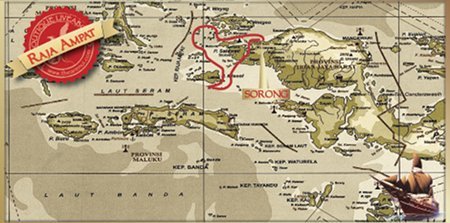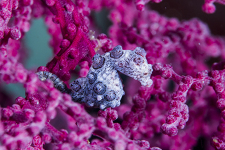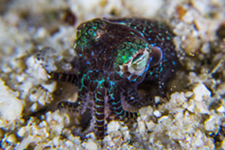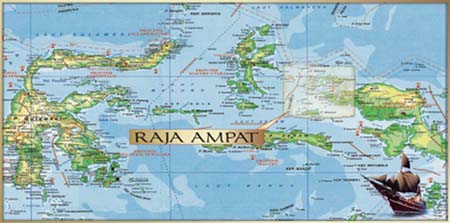2017 Arenui Raja Ampat - 11 Day / 10 Night
Sorong to Sorong Cruise $5,900 USD Per Person
Join our group on the Arenui for an end of the year celebration in Indonesia, cruising the waters of Raja Ampat. This is truly a bucket list destination. The charter embarks and disembarks in Sorong. Dates for this charter are December 12-22, 2017. When you enquire about our charter, ask for our agent's discount.
Additional Fees: Fuel Surcharge $100; Port Fee $150; Marine Park Fee $120.
Standard Inclusions: Full board accommodation in deluxe cabin; shore activities/excursions according to the program; soft drinks, water, tea, American/Balinese coffee; five meals per day, up to 4 dives/day; tanks, weights and weight belts; airport transfer; government taxes; 1/2 hour welcome massage.
Standard Exclusions: administration/port clearance fee; National Parks fee; fuel surcharge; international and domestic air; hotels and meals before and after the cruise; alcoholic drinks, espresso, cappuccino; dive equipment rental; nitrox; massages and spa treatments; travel insurance; onboard purchases; private tours; laundry; on-board telecommunications; crew gratuities.

Raja Ampat is the world's epicenter of marine biodiversity. In addition to varied corals, critters and pelagics, this destination offers vibrant and colorful underwater scenes plus also majestic landscapes, making it a perfect destination for keen photographers. The only problem with diving here, in Raja Ampat, is that you'll be so spoiled by the near-perfect conditions that you may never want to leave or dive anywhere else again.
Spread across 1,500 virtually untouched islands, the waters of the Raja Ampat region are home to the most colorful, pristine and photogenic soft coral reefs, as well as a wide range of creatures from walking sharks to mantas to pygmies. Raja Ampat can boast over 1,300 reef fish, 13 marine mammals, 5 species of endangered sea turtles, 600 hard corals and 75 % of all known coral species.


PAPUAN DIVE SITES
West of Sorong, Batanta Island will give you the chance to experience the amazing diversity of diving in Indonesia. Along the south coast are 2 incredible muck dives, where divers enjoy close encounters with all sorts of intriguing critters. At Black Beauty and Happy Ending look for tiger shrimps, ghost pipefish, mimic octopus and many nudibranchs. During the night bobbit worms, white V octopus and frogfish can be found hiding in the black sand.
In the south of Raja Ampat, we dive various sites around the large island of Misool. Dive at Nudi Rock, Whale Rock, Batu Kecil, Fiabecet Corner and Kalig Ridge. Wobbegong sharks hide under colourful coral shelves and the elusive Epaulette "walking" shark comes out at night. Marvel at the overhangs and bommies of Wedding Cake. At Wayili Rock, witness large schools of batfish, trevallies and barracuda. Explore Boo Rock and Boo Point, for large Napoleon Wrasse and Green Turtles. Try out your photo skills at Boo 'windows' as dive-buddies swim through the opening in the submerged rock past a reef draped in soft corals and brimming with fish.
South-east Misool is famous for the profusion of colourful soft corals and sea fans beautifully draped all over the reefs. If you're not one already, then diving in Misool will undoubtedly make you a huge fan of sea fans. Jump in at Neptune Fan Sea for a great drift dive, rushing along a gulley past giant and exquisitely-coloured gorgonian seafans.
East of Misool, we visit the Wagmab area. Drop in at Edi's Cave for something a little different, as we pop up half way through the dive to take a breath inside the cave! At the Wagmab Corner dive site, look for wobbegong sharks resting under ledges or on top of cup corals.
Back in central Raja Ampat, just north of Batanta (in the Gam area, south of Waigeo island), expect huge schools of fusiliers, snappers, surgeons, batfish and barracuda. Wobbegong, black tip and white tip sharks cruise the reefs here and look out for the elusive blue ring octopus creeping around the hard corals.
In south-west Gam, we dive at Arborek Jetty for pipefish, cuttlefish and octopus. The fish life in this area is plentiful. The newly discovered Pontohi pygmy seahorse can be found on the coral heads and see the giant clam nestled among the pulsing soft corals. At night listen for the toad fish croaking from under the rocks.
Also nearby, Manta Sandy is well-known for much bigger visitors, as it is one of the most consistent spots for finding congregating mantas. It's easy to spend a whole dive observing these majestic animals as they somersault through the water while being cleaned. If you're lucky, you'll be able to witness the unforgettable sight of a "manta train" - where a dozen or more mantas glide around and follow each other head-to-tail.
Heading to the northern Raja Ampat area, we visit a pearl farm in Aljui Bay (north-west side of Weigeo), to explore underneath the main jetty for wobbegong sharks, stonefish, hundreds of schooling scads, ghost pipefish, juvenile batfish and more. Nearby, the night dive is probably the best of the whole cruise, with a chance to see velvet fish, ghost pipefish, waspfish, coconut octopus, helmut flying gunnards and even the walking shark.
West of Waigeo, the rocks and seamounts in the Kawe area are truly singular as they actually sit on the equator. Kawe is one of the few places in the world where you can travel between the northern and southern hemispheres while diving! Yet, this is not the only reason to be excited about this dive. A combination of currents and feeding stations in this area combine to draw in a profuse amount of fish life, as well as huge mantas.
Cruising even further to the north, we visit the Wayag area. This isolated, uninhabited area sprinkled with verdant limestone islands, bordered by slivers of white sandy beaches and palm trees, represents what people usually have in mind when they think of paradise. The only thing to rival the landscape here is the diving. It is truly spectacular, with extensive and untouched hard coral reefs. As the majority of Wayag's islands have yet to be explored, it is very likely that many more dive sites will be found in this still remote area.
Returning to central Raja Ampat, we head to Dampier Strait, where nutrient-rich ocean currents create an incredible underwater environment. Everything which makes for a wonderful dive can be found here. Explore the dives sites of Cape Kri, Blue Magic, Chicken Reef, Otdima Reef, Kerupiar Island and Mioskon. Ironically, sardines are about the only reef fish not found at the site of Sardine Reef, but you won't even notice as fusiliers, surgeonfish, trevallies, rainbow runners, sweetlips and bannerfish practically block out the sky, as they swarm over a reef decorated with sea fans, soft corals and huge orange elephant ear sponges encrusted with pastel colonies of tunicates. One of the more unique thrills of this site is being able to hear "fish thunder" - the loud booming sound made when a large number of fish move rapidly through open water.
